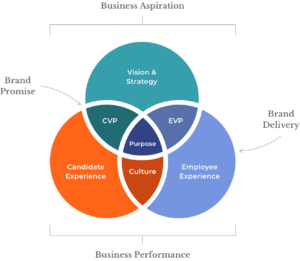Attracting and retaining skilled professionals is critical to your company’s success. But how do you stand out in a crowded marketplace with a compelling employer value proposition? The answer lies in a powerful two-pronged approach: employer branding and talent marketing. While these terms are often used interchangeably, they represent distinct, yet interconnected, strategies. Here’s a roadmap to help tech leaders leverage both to build a talent magnet and win the war for talent.
[ez-toc]Section 1: Employer Branding 101: Building a Foundation

The right strategies to hire software developers cost-effectively, combine talent pools, compensation packages, and building a strong employer brand to attract top talent who value more than just a paycheck. Photo by Brooke Cagle.
Employer branding and talent marketing are critical for tech leaders to attract and retain top talent. By leveraging effective recruitment marketing tactics and creating a strong employer value proposition and enhancing company culture, you can win the war for talent in the competitive tech industry. Attracting fresh talent is often the main goal, but employee engagement and workforce retention are also key aspects. Discover effective strategies to build a talent magnet today.
Two Core Concepts You Should Know
Let’s start with the core concept. Your employer brand is essentially your company’s reputation as a workplace. It encompasses everything from your company culture and values to your employee experience and the way you present yourself to the outside world.
A strong employer brand attracts top talent who share your values and aspirations, ultimately driving innovation and business growth. This involves defining a strong employer value proposition that resonates with your target candidates.
#1 What is the Difference Between Commercial Brand and Employer Brand?
Your commercial brand focuses on the products or services you offer to customers. Your employer brand, on the other hand, focuses on the value proposition you offer to potential employees. A well-defined employer value proposition is crucial to this process. It communicates why someone would want to work at your company, beyond just a paycheck.
#2 Who Owns the Employer Brand?
While employer branding efforts might be spearheaded by the HR or marketing department, it’s truly a collective responsibility. Every employee, from the CEO to the intern, plays a role in shaping the company’s company culture and reputation.
Relevant Terminology
More than Buzzwords and Expressions, these are key elements of Employer Branding and Talent Marketing you need to muster before you go deeper.

Talent Marketing is an amalgamation of culture, strategy, assets and intentional actions. Image source: HCCR.
Examples of Employer Branding
Here are some examples of companies with strong employer brands and their angle for their employer branding strategies:
- Google: Known for its innovative culture, employee perks, and commitment to work-life balance.
- HubSpot: Emphasizes a culture of growth, remote work opportunities, and a strong sense of community.
- Salesforce: Recognized for its focus on social responsibility, diversity and inclusion initiatives, and commitment to employee wellbeing.
Assessing and Defining Your Employer Brand: Practical Tips
So, how do you assess and define your existing employer brand? Here are some practical tips:
- Gather employee feedback: Conduct surveys and hold focus groups to understand employee perceptions of your company culture and values.
- Review online reviews: Look for recurring themes in employee reviews on Glassdoor and other platforms.
- Analyze job candidate data: Examine why candidates choose or reject your company offers. Conducting a thorough candidate journey analysis can also provide valuable insights.
- Benchmark against industry leaders: Analyze employer branding strategies of successful companies in your space.
Section 2: The Power of Storytelling – Crafting Your Employer Narrative

What comes next for software experts? Learn 4 essential skills: adaptability, thinking, digital fluency, storytelling & more. Photo by LinkedIn Sales Solutions.
Once you have a grasp of your employer brand foundation, it’s time to craft a compelling employer narrative. This narrative is the story you tell the world about what it’s like to work at your company.
Storytelling in employer branding is crucial because it allows you to connect with potential candidates on an emotional level, making your company culture and values more relatable and engaging.
How to Craft Your Employer Narrative
To craft a compelling employer narrative, focus on showcasing your company culture and values through real-life stories and examples. Highlight what makes your work environment unique and how your company empowers employees to grow and thrive.
- Identify your target audience: Who are you trying to attract? Tailor your message to resonate with their values and career aspirations to enhance the candidate journey.
- Highlight your unique selling proposition (USP): What makes your company culture special? Focus on differentiating factors like innovation, flexibility, or a strong sense of community.
- Use authentic storytelling techniques: Showcase your employer brand through employee testimonials, blog posts, social media content, and career page stories. Integrating recruitment marketing techniques can amplify your reach.
Effective Employer Storytelling Examples Across Channels
Mailchimp: Known for their playful and engaging social media presence, Mailchimp’s career section uses humor and behind-the-scenes glimpses to showcase their employee culture.

Talent Marketing example: MailChimp’s career section has a dedicated employee blog showcasing team members
Warby Parker: Their instagram uses vibrant visuals and employee quotes to showcase their fun and collaborative company culture.
GitLab: GitLab’s blog has a dedicated category that features blog posts like “A Day in the Life of a [Job Title]” which provide a realistic look at employee experiences.
Section 3: From Brand to Action – Building a Talent Marketing Engine

Optimize each stage of your funnel, from crafting compelling job descriptions to conducting effective candidate attraction strategies and technical skills assessments. Photo by Amy Hirschi.
Now that you have a strong employer brand narrative, it’s time to amplify it through talent marketing.
Why is Talent Marketing Important?
Effective talent marketing offers numerous benefits:
- Reduced recruitment costs: Strong employer branding attracts qualified candidates, reducing the need for expensive advertising or headhunting fees. Pro Tip: Building a team of brand ambassadors can significantly boost your efforts.
- Improved candidate experience: Well-crafted talent marketing creates a positive first impression and ensures a smooth candidate journey.
- Increased hiring efficiency: By attracting the right talent pool, you can streamline the hiring process and make faster hiring decisions.
- Enhanced employer reputation: A strong employer brand strengthens your overall company image.
- Improved employee engagement and morale: When employees feel proud to be part of a company with a positive reputation, they’re more likely to be engaged, motivated, and productive. Focus on employee engagement to ensure your team remains motivated and productive.
- Boosted customer satisfaction: A strong employer brand often translates to a happier and more dedicated workforce. This, in turn, can lead to better customer service and satisfaction.
- Enhanced ability to attract investors and partners: Investors and partners are more likely to be drawn to companies with a strong employer brand, as it signifies a stable and well-managed organization.
- Reduced risk of negative publicity: A positive employer brand can help mitigate the impact of negative press or online reviews.
Building a Talent Magnet: Strategies for Effective Talent Marketing
Here is a checklist of key talent marketing strategies to supercharge your employer brand and attract the best talent:
- Develop a compelling Employer Value Proposition (EVP): Your EVP is the core message that tells candidates why they should choose your company over competitors. It should highlight your unique benefits, career development opportunities, and company culture.
- Leverage Social Media for Talent Acquisition: Utilize platforms like LinkedIn, Twitter, and Facebook to showcase your company culture, share employee stories, and post engaging job content. Build a strong employer brand presence and actively participate in relevant online communities where your target talent gathers.
- Create Engaging Career Content: Go beyond basic job descriptions by incorporating insights from your employer value proposition. Craft informative blog posts, articles, and videos that showcase your company’s work environment, employee benefits, and career growth opportunities.
- Build Relationships with Universities and Recruitment Agencies: Partner with universities and recruitment agencies that specialize in your industry. These partnerships can help you connect with highly qualified talent pools.
- Make Use of Targeted Advertising and Online Communities: Leverage online advertising platforms like LinkedIn Ads to target specific talent segments based on skills and experience. Participate in industry-specific online communities and forums to engage with potential candidates.
- Embrace Data-Driven Recruitment: Track and analyze the effectiveness of your talent marketing initiatives. Use data insights to optimize your strategies and target the right talent with the right message.
Section 4: Authenticity is Key – Maintaining Your Employer Brand Promise

Trust-building is an ongoing dialogue that requires commitment and a touch of creativity.
Live your employer brand values. Ensure your company practices what it preaches. Walk the walk, not just talk the talk.
There’s nothing worse than attracting talent with a misleading narrative, only to have them disillusioned upon joining the company. Here’s how to ensure your employer brand remains genuine and fosters trust with potential candidates:
Risks of Employer Brand Inauthenticity
While a strong employer brand attracts talent, inauthenticity can backfire, leading to several damaging consequences for your talent acquisition efforts:
- Damaged Reputation: A misleading employer brand can lead to negative online reviews and a tarnished company image, making it harder to attract top talent.
- High Turnover: Employees disillusioned by a fake employer brand are more likely to leave, resulting in high turnover costs and a weakened talent pool.
- Wasted Resources: Attracting candidates with an inauthentic brand leads to wasted time and resources during the recruitment process.
- Loss of Employee Trust: Inconsistent messaging between the employer brand and company culture erodes employee trust and morale.
For more on this, you may want to read our content piece on Tackling Candidate Abandonment: 4 Steps for Effective Tech Recruitment Strategies for SaaS Expansion.
4 Best Practices
A strong employer brand is only effective if it’s built on a foundation of authenticity. Here are 4 ways to maintain a consistent and genuine Employer Brand across all touchpoints:
- #1 Align Your Employer Brand With Your Company Culture: Don’t try to create a utopian vision that doesn’t exist. Your employer brand should be a realistic reflection of your company culture, highlighting both the positives and the areas where you’re actively striving to improve.
- #2 Empower Employees as Brand Ambassadors: Encourage your employees to share their authentic experiences on social media and online platforms. This fosters trust with potential candidates who can relate to the real-life stories and perspectives from current employees.
- #3 Live Your Employer Brand Values: Actions speak louder than words. Ensure your company practices what it preaches. If your employer brand emphasizes innovation, empower employees to experiment and take calculated risks. If you promote work-life balance, offer flexible work arrangements and discourage a culture of overwork.
- #4 Address Negative Feedback Responsibly: No company is perfect, and occasionally you may receive negative feedback online or through employee reviews. The key is to address these concerns honestly and transparently. Demonstrate a willingness to learn and improve, showcasing your commitment to maintaining a positive and authentic employer brand.
Align your recruitment marketing efforts with your overall strategy, and do the same for your engagement and motivation policies and procedures.
Conclusion: Building a Sustainable Talent Acquisition Pipeline

A healthy talent acquisition pipeline makes recruiters’ lives much easier – and results in seamless candidate experience. Photo by Brooke Cagle.
Combine a strong employer brand with effective talent marketing strategies to attract top talent, build a loyal workforce, and fuel your company’s growth. By focusing on employee engagement and workforce retention, you can build a loyal and productive team.
Remember, employer branding and talent marketing are not one-time initiatives – they require ongoing commitment and continuous improvement.
Ready to build a talent magnet? Reach out to Ubiminds to build your employer brand and talent marketing efforts in Latin America. Attract and retain the best talent, the business as a whole will gain a significant competitive advantage!

International Marketing Leader, specialized in tech. Proud to have built marketing and business generation structures for some of the fastest-growing SaaS companies on both sides of the Atlantic (UK, DACH, Iberia, LatAm, and NorthAm). Big fan of motherhood, world music, marketing, and backpacking. A little bit nerdy too!



